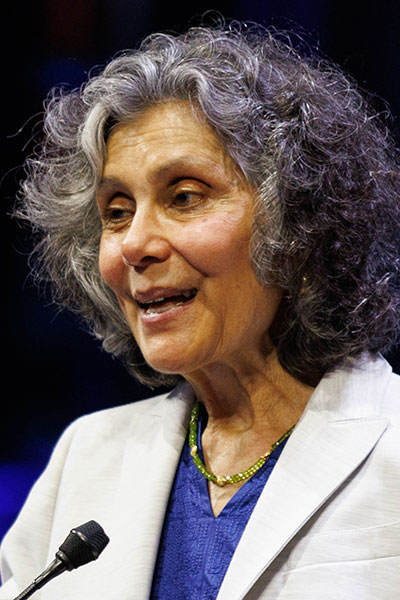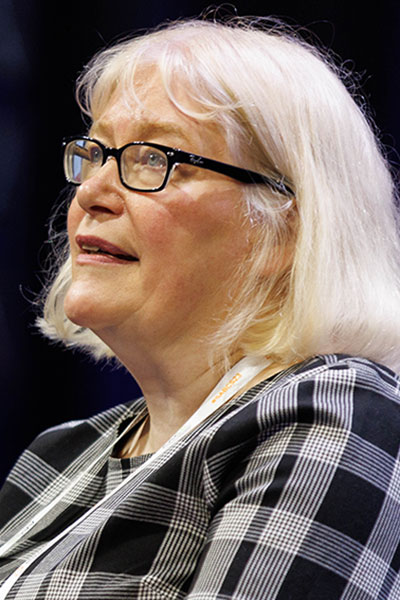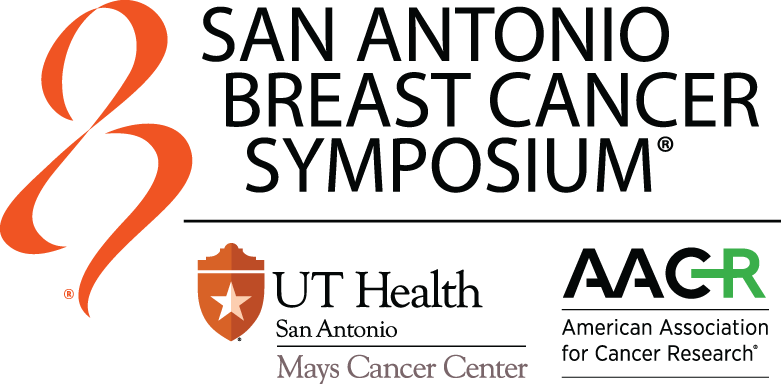During General Session 3 at the 2023 SABCS® on Friday morning, researchers presented findings from 11 studies, including late-breaking, practice-changing results from the KATHERINE, and INAVO120 trials. The entire session is available on demand for registered participants of the 2023 SABCS® through March 31, 2024, on the meeting platform.
GS03-01: Magnetic Resonance Imaging and a 12-Gene Expression Assay to Optimize Local Therapy for Ductal Carcinoma In Situ: 5-year clinical outcomes of ECOG-ACRIN 4112

Patients with low-risk ductal carcinoma in situ (DCIS) who skipped adjuvant radiotherapy after breast-conserving surgery had comparable five-year outcomes to those with high-risk DCIS who received adjuvant radiotherapy, according to results from the ECOG-ACRIN 4112 clinical trial.
Findings from the study were presented by Seema Khan, MD, Professor of Surgery and the Bluhm Family Professor of Cancer Research at the Feinberg School of Medicine and Lurie Comprehensive Cancer Center of Northwestern University.
“Surgical decisions for DCIS are initiated by the lesion detection on mammogram, followed by core needle biopsy. MRI is more sensitive for DCIS detection than mammography and has been suggested as a way to aid surgical decisions,” Dr. Khan said. “For radiotherapy decisions, this has become very important since there is accumulating data regarding the lack of benefit, or small benefit, for women with low-risk DCIS. These decisions can be aided by the use of molecular assays such as the DCIS Score, which is a 12-gene assay derived from the 21-gene recurrence score.”
The goal of ECOG-ACRIN 4112 was to assess the potential of bilateral MRI coupled with a DCIS gene profile to guide treatment for patients with DCIS. Previously reported results from this trial indicated that MRI could help to identify patients who could opt for the less intensive breast-conserving surgery instead of a mastectomy.
In the study analysis, which included 171 patients with DCIS who underwent breast-conserving surgery and whose tumor tissue was profiled using the DCIS Score test, patients who received a score lower than 39 were considered to have low-risk DCIS and were eligible to skip adjuvant radiotherapy, while patients with scores 39 or higher were recommended to receive adjuvant radiotherapy.
Among their findings, Dr. Khan reported that, after a median follow up of five years post-surgery, 5.1% of the patients with low-risk DCIS and 4.5% of the patients with high-risk DCIS experienced disease recurrence in the same breast as the primary DCIS. Similar results were found when comparing only those patients who adhered to the score-based recommendations: 5.5% of patients with low-risk DCIS who skipped radiotherapy experienced disease recurrence, as compared with 4.8% of patients with high-risk DCIS who received radiotherapy. The differences were not statistically significant nor influenced by patient age in either analysis.
“Women with intermediate- and high-score DCIS who received radiotherapy experienced an IBE [ipsilateral breast event] rate that was approximately two-thirds lower than previously reported in a similar population; however, when the DCIS score was low, the IBE rate was fairly similar to prior studies where radiotherapy omission was based on either low grade or low DCIS score,” Dr. Khan said. “An analysis of 10-year IBE outcomes from this trial will be very important and is planned, and larger prospective studies are under consideration.”
GS03-02: Mammographic surveillance in early breast cancer patients aged 50 years or over: Results of the Mammo-50 non-inferiority trial of annual versus less frequent mammography

Women 50 or older who de-escalated to less-frequent mammography three years after curative surgery for early-stage breast cancer had similar outcomes to women who received annual mammography, according to results from the Mammo-50 trial, which were presented by Janet A. Dunn, PhD, Professor in the Clinical Trials Unit at the University of Warwick in the U.K.
“We know that annual mammograms are a significant cost burden to the health care system and cause anxiety to patients, and so this study was a commissioned call from our funding body to gather further evidence and to determine the optimum frequency and duration of mammographic surveillance,” Dr. Dunn said. “The primary outcome was disease-specific survival and cost effectiveness, with a range of secondary outcomes, including recurrence-free interval and overall survival. An important part of this study was a quality-of-life substudy for which we used four validated scales to collect data from patients annually.”
The Mammo-50 trial enrolled 5,235 women who had undergone curative surgery to remove their cancer, were free of recurrence three years post-surgery, and were 50 or older at the time of diagnosis. Participants were randomly assigned 1:1 to receive annual mammography or less-frequent mammography, defined as every two years in patients who underwent breast conservation surgery and every three years in patients who had a mastectomy.
After five years of follow up, Dr. Dunn reported that breast cancer-specific survival was 98.1% and overall survival was 94.7% among patients in the annual mammography arm. For patients receiving less frequent mammography, breast cancer-specific survival was 98.3%, and the overall survival was 94.5%. Similarly, at five years, 5.9% of patients in the annual mammography arm and 5.5% of patients in the de-escalation arm had experienced a recurrence.
The investigators found that compliance with the assigned mammography schedule was lower among patients assigned to the de-escalation arm (69%, compared to 83% among patients assigned to the annual arm). The concurrent quality-of-life substudy detected no differences between trial arms.
“Mammo-50 demonstrated that, for patients aged 50 years or older and three years post-diagnosis, less frequent mammograms were non-inferior to annual, but there is a need to have a mechanism for easy access back into the system for symptom management and ongoing support for a small percentage of patients who may need that,” Dr. Dunn said. “We believe Mammo-50 provides evidence for changing clinical practice.”
GS03-12: Phase III study of adjuvant ado-trastuzumab emtansine vs trastuzumab for residual invasive HER2-positive early breast cancer after neoadjuvant chemotherapy and HER2-targeted therapy: KATHERINE final IDFS and updated OS analysis

Ado-trastuzumab emtansine (T-DM1) improved post-surgical survival outcomes over trastuzumab in patients with HER2-positive early breast cancer with residual invasive disease after neoadjuvant therapy, according to late-breaking updates from the phase III KATHERINE study.
Invasive disease-free survival (IDFS) and overall survival (OS) outcomes from the study were presented by Sibylle Loibl, MD, PhD, Chief Executive Officer and Chair of the German Breast Group and Associate Professor of Obstetrics and Gynecology at Goethe University.
Patients who do not achieve pathologic complete response in this setting— seen in 40% to 60%—have poor outcomes. KATHERINE assessed the value of switching from their current HER2-directed therapy to single-agent T-DM1.
Dr. Loibl set the stage by discussing the study design; the primary endpoint was IDFS and OS was a key secondary endpoint. Key eligibility criteria included: Prior neoadjuvant therapy consisting of 6 cycles of chemotherapy (CT), ≥9 weeks of trastuzumab (treatment with a second HER2-targeted agent was allowed) and residual invasive tumor in breast or axillary nodes. Patients were randomized 1:1 to receive either T-DM1 (743 patients randomized, 740 treated) or trastuzumab (743 randomized, 720 treated) within 12 weeks of surgery.
Primary analysis, conducted in 2018, showed significant improvement in 3-year IDFS with T-DM1, compared with trastuzumab (88.3% vs 77% trastuzumab ). OS data were immature.
Dr. Loibl presented findings from the final IDFS analysis and second interim OS analysis at 2023 SABCS®, at a median follow-up of 8.4 years.
The final IDFS analysis showed sustained improvement in IDFS with T-DM1, compared with trastuzumab. Landmark 7-year IDFS rates increased from 67.1% with trastuzumab to 80.8% with T-DM1. T-DM1 significantly reduced the risk of death, by 34%, compared with trastuzumab .
Dr. Loibl said, “Subgroup analyses of IDFS underline the treatment effect of T-DM1 across subgroups,” including patients with HR+ and HR− disease, and in those who received dual HER2 blockade in the neoadjuvant setting.
The landmark 7-year median OS was improved, from 84.4% with trastuzumab to 89.1% with T-DM1. Consistent with the IDFS results, OS benefits were also improved with T-DM1 over trastuzumab across all subgroups. Notably, Dr. Loibl added, “the greater the residual disease, the more impactful the T-DM1 benefit,” in terms of the OS outcome.
There were no significant differences between the treatment arms in terms of the use of follow-up medications after IDFS event. Moreover, analyses of related adverse event (AE) data did not reveal any new safety signals with the longer follow-up. The occurrence of cardiac disorders was a rare AE in both arms (0.7% in both arms).
Dr. Loibl concluded, “T-DM1 is the first therapy to show improved survival post-surgery in patients with HER2-positive early breast cancer with residual invasive disease after neoadjuvant therapy.”
GS03-13: Phase III study of inavolisib or placebo in combination with palbociclib and fulvestrant in patients with PIK3CA-mutant, hormone receptor-positive, HER2-negative locally advanced or metastatic breast cancer: INAVO120 primary analysis

Inavolisib in combination with palbociclib and fulvestrant may represent a new standard of care for endocrine therapy-resistant PIK3CA-mutated, HR+, HER2- advanced breast cancer (ABC), according to the primary analysis of data from the INAVO120 study.
Late-breaking findings from the study were presented by Komal L. Jhaveri, MD, FACP, Breast Oncologist at the Breast and Early Drug Development Service, Memorial Sloan Kettering Cancer Center.
Combination therapy with CDK4/6 inhibitors (CDK4/6i) and endocrine therapy (ET) is the current standard of care for patients with estrogen receptor-positive (ER+) ABC. However, development of acquired resistance to this doublet approach is nearly inevitable. Therefore, there is a need for additional therapies for patients with resistance to CDK4/6i-ET combination treatment.
Dr. Jhaveri said, “PI3Kα inhibitors to date have faced challenges with safety and tolerability. Inavolisib is a highly potent and selective PI3Kα inhibitor that also promotes the degradation of mutant p110α, which may improve the therapeutic window.” She alluded to preclinical data, which show a synergistic anti-tumor effect of PI3K inhibitors when combined with CDK4/6is and ET.
The phase III INAVO120 study compared inavolisib, in combination with palbociclib (a CDK4/6i) and fulvestrant (an ET), to placebo with palbociclib and fulvestrant in patients with PIK3CA-mutated, HR+, HER2- ABC who recurred on or within 12 months of adjuvant ET. A key inclusion criterion in the study was good/normal glucose control (fasting glucose <126 mg/dL and HbA1C <6.0%). Patients were randomized 1:1 to the inavolisib triplet (161 patients) or the doublet therapy (164 patients) until progressive disease or toxicity. The PIK3CA status was evaluated using central/local tissue or circulating tumor DNA (ctDNA)-based testing.
Dr. Jhaveri presented findings from the primary analysis, which showed “statistically significant and clinically meaningful” improvement in investigator-assessed progression-free survival (PFS). After 21.3 months median follow-up, median PFS was 15 months in the inavolisib arm and 7.3 months in the placebo arm (hazard ratio 0.43; p<0.0001). Median PFS in the inavolisib arm at 6, 12, and 18 months was 82.9%, 55.9%, and 46.1%, respectively, compared to 55.9%, 32.6%, and 21.1% in the placebo arm.
In addition, improvements were also seen in key secondary endpoints and across subgroups. Interim overall survival (OS) analysis showed a trend that favored the inavolisib triplet over the doublet (median OS, NE vs. 31.1 months; stratified hazard ratio 0.64). Overall response rate and clinical benefit rate were also higher with the triplet. The inavolisib triplet improved PFS in most subgroups, including patients younger than 65 years old, pre- and post-menopausal patients, and those with/without visceral disease or liver metastases at enrollment.
Dr. Jhaveri noted that, in INAVO120, the safety profile of the triplet was comparable to that of the individual drugs.
Following are all of the abstracts presented during General Session 3:
GS03-01: Magnetic Resonance Imaging and a 12-Gene Expression Assay to Optimize Local Therapy for Ductal Carcinoma In Situ: 5-year clinical outcomes of ECOG-ACRIN 4112
GS03-02: Mammographic surveillance in early breast cancer patients aged 50 years or over: results of the Mammo-50 non-inferiority trial of annual versus less frequent mammography
GS03-03: Ribociclib (RIB) + nonsteroidal aromatase inhibitor (NSAI) as adjuvant treatment in patients with HR+/HER2− early breast cancer: final invasive disease–free survival (iDFS) analysis from the NATALEE trial
GS03-04: Novel Mechanisms of CDH1 Inactivation in Breast Invasive Lobular Carcinoma Unveiled by the Integration of Artificial Intelligence and Genomics
GS03-06: Genomic and transcriptomic profiling of primary tumors from patients with HR+, HER2-, node-positive, high-risk early breast cancer in the monarchE trial
GS03-07: Protocol-defined biomarker analysis in the PALLAS (AFT-05) adjuvant trial: Genomic subtype derived from RNA sequencing of HR+/HER2- early breast cancer.
GS03-09: Characterization and proposed therapeutic exploitation of fusion RNAs in metastatic breast cancers
GS03-10: Allosteric PI3K-alpha inhibition overcomes on-target resistance to orthosteric inhibitors mediated by secondary PIK3CA mutations
GS03-11: Germline-mediated immunoediting sculpts breast cancer subtypes and metastatic proclivity
GS03-12: Phase III study of adjuvant ado-trastuzumab emtansine vs trastuzumab for residual invasive HER2-positive early breast cancer after neoadjuvant chemotherapy and HER2-targeted therapy: KATHERINE final IDFS and updated OS analysis
GS03-13: Phase III study of inavolisib or placebo in combination with palbociclib and fulvestrant in patients with PIK3CA-mutant, hormone receptor-positive, HER2-negative locally advanced or metastatic breast cancer: INAVO120 primary analysis

